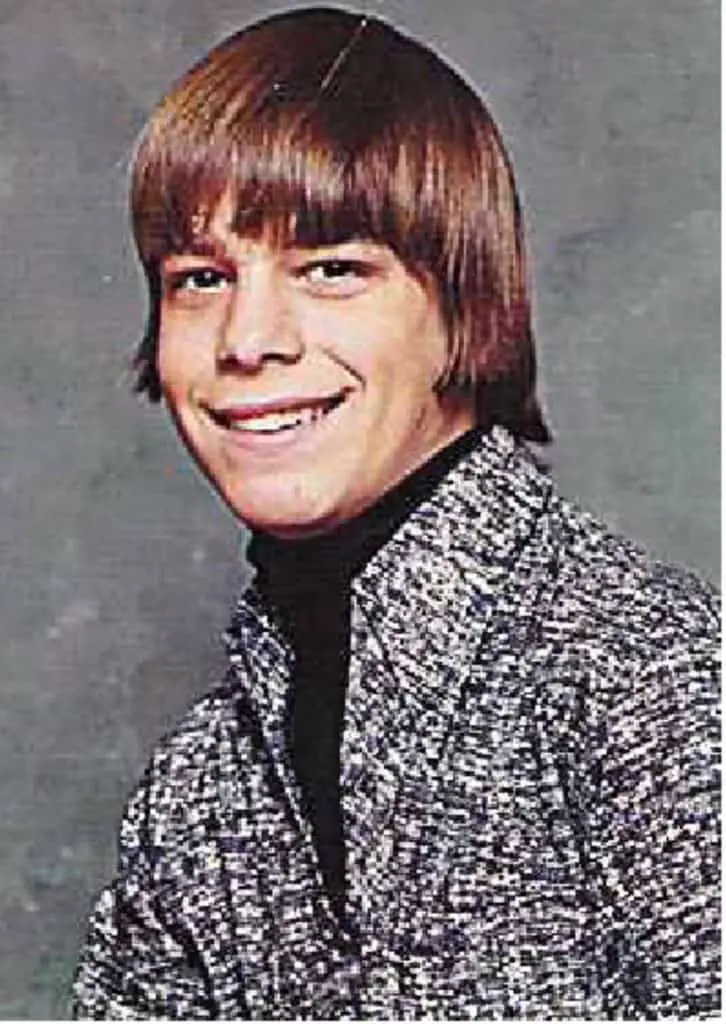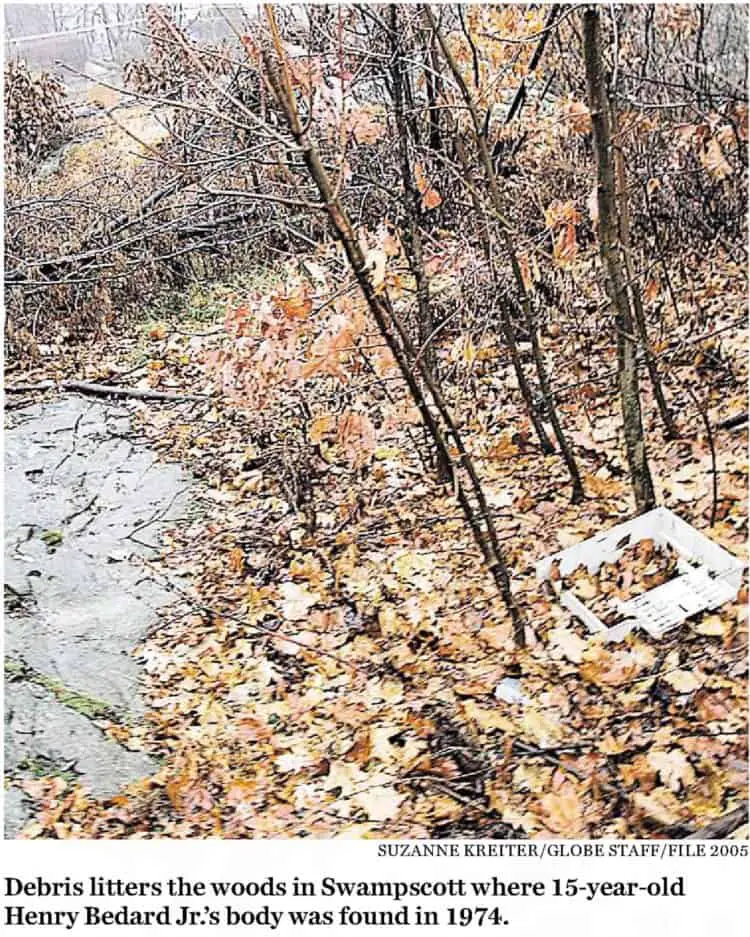BOSTON — Henry Bedard Jr. was born on June 25, 1959, to Henry Sr. and Gloria Bedard. He has four siblings: John, Cheryl, Stephen, and Scott.
The Bedard family resided at 21 MacArthur Circle in Swampscott, Massachusetts, a charming New England coastal town. They had previously lived in neighboring Lynn.
The Bedards lead an idyllic life – the American Dream if you will. They lived in a lovely split-level home at the end of a cul-de-sac in a modest neighborhood.
In the early 1960s, Henry Sr. purchased a summer cottage in Hampstead, New Hampshire, and thereafter, the family spent each summer there.
Henry Bedard Jr. was a happy teenager. His favorite holiday was Christmas, and his parents joyously decorated the house each year. In terms of decoration, Christmas 1974 was no different, but a horrific event that holiday season changed the Bedard family’s lives forever.
On December 16, 1974, Henry, 15, walked his younger brother to school before heading to Swampscott High School, then on Greenwood Avenue, where he was a sophomore.
After school, he took the bus to Vinnin Square Plaza. Between 2:30 pm and 3 pm, he was at CVS Pharmacy, where he dropped off a roll of 8-millimeter film for development and bought a perfume bottle for his sister, Cheryl, for Christmas.
Around 3 pm, then-lieutenant Peter Cassidy noticed Henry walking along the busy Paradise Road and waved to him.
Peter told The Boston Globe in 2004, “He looked like he was in a hurry to get somewhere.”
Forty minutes later, city workers saw Henry cross the Department of Public Works (DPW) yard at 200 Paradise Road, about a mile south of CVS Pharmacy. He hollered “Merry Christmas” and told the workers he was going home to wrap Christmas gifts. Henry walked into the woods and onto the path of a former Boston & Maine rail line and then hiked up the rocky hill known as Swampscott View. He was never seen alive again.
Cliff Goodman, who lived nearby, was preparing for his 10th birthday party. Two of his friends arrived around 4 pm. Unbeknownst to anyone, they had found an empty wallet and a CVS shopping bag containing a perfume bottle on the ledge behind Cliff’s home.
When Henry had not returned home by 5:30 pm, his parents knew something had happened because he was always home by then.
Darkness fell, followed by heavy rain. At 7 pm, friends and family members drove around Swampscott looking for Henry, but they never found him.
The Bedards reported their son missing at 9:15 pm; however, the officers immediately assumed he had run away. Henry’s parents insisted he had no reason to, and he did not have a history of running away.
The next day at school, one of Cliff Goodman’s friends told him about the wallet and CVS bag. They later went to the spot and looked through the leaves for the items. The location is on a rocky hill known as Swampscott View.
As they searched for the items, the boys found the bloody body of Henry Bedard, Jr. hidden under some leaves. A 31″ Louisville Slugger baseball bat was a few yards away on the cold, wet ground.
The boys ran to a nearby home, and the homeowner called the Swampscott police.
Police arrived at the scene, but it did not provide much as far as clues go. The only evidence appeared to be the baseball bat with the Roman numeral VI carved into the bottom.
Henry’s high school baseball team used the same type of bat, but investigators learned that most high school teams used it as well.
Authorities initially thought Henry had been shot to death until an autopsy revealed he had been struck on the head numerous times with the baseball bat. Six months after the murder, investigators sent the bat to the State Police lab in Boston for analysis. A technician found an impartial fingerprint, and in a subsequent examination in 1998, found a second impartial print. However, Henry had not been fingerprinted, so they could not determine if the prints belonged to Henry or his killer. They also never found the owner of the bat.
Investigators interviewed numerous people and administered polygraph tests to nine teenagers; they all passed. The city workers who saw Henry did not hear any screams or other sounds coming from Swampscott View.
On the morning of Henry’s death, he was seen by Mr. Spencer at school, arguing with another student over what seemed to be “money.” Both Henry and that student were missing from their last period class. They were marked absent. Mr. Spencer has since passed away.
Cheryl Bedard-Armas, Remembering Henry Bedard Jr., 2011
Henry’s wallet contained no money, suggesting robbery might have been the motive. However, it’s unknown how much money Henry had on him that day.
The route Henry had taken that day was not his usual route. He and another student often walked home from school together, and they never used the clearing as a shortcut. Investigators believe he went to meet someone or a group of people.
A $10,000 reward fund was established to help find the killer, but no one came forward with information.
In 2003, Henry’s clothing and the baseball bat were sent for DNA testing. Authorities were hoping to match the two partial fingerprints found on the bat. No one has ever been arrested in Henry’s death.
In 2011, Henry’s former girlfriend, Cindy Cavallaro, started a Facebook page, hoping it would help bring more information in his case. Cindy attended her eighth-grade prom with Henry. While the page renewed attention and brought new leads, it no longer exists.
Swampscott High School was originally located on Greenwood Avenue. Two years ago, it was demolished and rebuilt on Essex Street. Condominiums now stand in the high school’s original spot. During demolition, crews unearthed a 124-year-old time capsule.
The murder of Henry Bevard, Jr. devastated his family. Henry Sr. and Gloria Bedard eventually divorced and moved away. Gloria died in 2014. Cheryl, who was 18 and in college at the time of his death, blamed herself for her brother’s death because he had bought her the perfume that day. Maybe if he hadn’t, he’d still be alive, she thought.
Cheryl Bedard-Armas has not written in her blog since 2015.
True Crime Diva’s Thoughts
A big “THANK YOU” to Matthew for suggesting this case!
It appears Henry was not sexually assaulted, so that was not the motive. Beating someone with a bat is personal, no doubt. I agree with the police that the killer was someone he knew, not necessarily a friend, though. Maybe it was the student arguing with him over money. Who was he? Were they just classmates or did they hang out together?
I’m assuming Henry owed this kid money, and he didn’t have it or refused to give it to the other boy. Maybe Henry wanted to see how much money he had left over after he went Christmas shopping and told the kid to meet him afterward at the location where he was found dead. Was this kid angry enough to kill over the money? I’m skeptical in a way because it could not have been a large amount. However, some people kill for the smallest and dumbest reasons.
If Henry meant to return home after shopping, it would have been quicker for him to walk from Vinnin Square to Essex Street, turn right at Burpee Road then turn right on Macarthur Circle. It made zero sense to walk all the way to DPW and cut through. So, that is why I believe he was planning to meet someone at Swampscott View.
I also wonder this: It only takes 15 minutes to walk from CVS to DPW. He was seen two-fifths of a mile south of CVS by Peter Cassidy at 3 pm. He was seen at 3:40 by DPW workers. Why did it take him 40 minutes to walk from CVS to DPW? Did he stop by somewhere in between? Talk to anyone?
Chances are, whoever killed him was not alone. I think others might have witnessed the murder. Whoever murdered Henry was angry, so what was the reason?
Was Henry ever bullied? It appears he was genuinely well-liked, but he was also a small teenager. Bullies sometimes stalk their victims in packs, like wolves. Perhaps that was the case here.
I would wager some people in that town knew who owned the baseball bat and who killed Henry. I believe his killer might have been on the high school baseball team.
There’s no doubt in my mind that Henry’s killer was also a teenager at the time. High school students gossip, so you know some of these kids knew who killed Henry.
Sources
Bedard-Armas, Cheryl. Remembering Henry Bedard Jr. (blog). Accessed December 20, 2020. https://henrybedard.wordpress.com/
Rosenberg, Steven. “Regarding Henry.” Boston Globe. December 16, 2004. Accessed December 20, 2020. https://newspapers.com.
Rosenberg, Steven. “Dead-End Case Turns to Facebook.” Boston Globe. January 30, 2011. Accessed December 20, 2020. https://www.newspapers.com.





